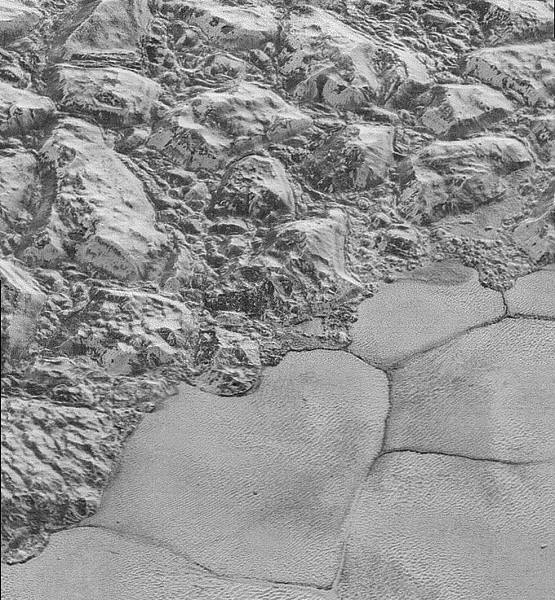New Pluto Images Reveal Best Ever, Sharpest Photos of Its Surface
| Ana Verayo | | Dec 04, 2015 10:46 PM EST |
(Photo : NASA/JHUAPL/SwRI) The Mountainous Shoreline of Sputnik Planum: In this highest-resolution image from NASA’s New Horizons spacecraft, great blocks of Pluto’s water-ice crust appear jammed together in the informally named al-Idrisi mountains.
NASA's New Horizons probe just released the most stunning, high resolution photos of dwarf planet Pluto, some 15 minutes when it zoomed past Pluto on July 14. This view of Pluto's frigid surface reveals never before seen details as close as 250 feet across, almost less than half the size of a city block.
Like Us on Facebook
According to New Horizons principal investigator, Alan Stern, these new images are simply breathtaking and at taken at super high resolution, revealing Pluto's stunning geology. This kind of technology has not been available for other flybys in the last few decades such as Venus or Mars, but for Pluto, its craters, mountains and ice fields are shown in less than five months after the flyby. The science that can be obtained from these images are simply unbelievable.
The images captured part of this strip measuring 50 miles beginning from Pluto's horizon and then stretching across a cratered terrain, revealing the jigsaw puzzle-like al-Idrisi mountains and a shoreline border between the mountains and the heart shaped region known as Sputnik Planum towards the icy plains.
These images are captured courtesy of the New Horizons' LORRI instrument (Long Range Reconnaissance Imager) within a distance of just 10,000 miles from Pluto's dynamic surface. What's different from these pictures than the previous ones is that, these are the sharpest ones yet, providing stunning views of vistas.
The photos reveal, dune like features on the frozen plains of Sputnik Planum and an intersection across this mountain region. With this resolution, the mountains becoming incredibly stunning, says New Horizons' John Spencer. There are new details shown such as crumpled ridges and rubble like material surrounding the mountains. It seems like these mountains were jostled, transferring them to their current locations via huge ice blocks.
This image strip also reveals large craters in almost precise details, showing dark layers and regions where it appears as if ice has been transported there. Another image shows a mountainous region known as "The Badlands" showing interesting faults and erosions.
According to NASA's Science Mission Directorate director, John Grunsfeld, these photos are demonstrating the power of robotic planetary explorers that can return tantalizing data to scientists back on Earth. New Horizons is now under transmission of a treasure trove of images and data from its onboard memory back to mission control, and the team is constantly amazed.
Pluto is located more than 3 billion miles from Earth, and as New Horizons is heading towards the Kuiper Belt, almost 5 billion miles away from our planet, it will take 16 months for the probe to beam back all the data recorded from its epic Pluto flyby last July.
TagsNASA New Horizons, Pluto new horizons, sharpest images of pluto, new images of pluto, pluto surface photos, pluto geology, NASA new horizons pluto
©2015 Chinatopix All rights reserved. Do not reproduce without permission
EDITOR'S PICKS
-

Did the Trump administration just announce plans for a trade war with ‘hostile’ China and Russia?
-

US Senate passes Taiwan travel bill slammed by China
-

As Yan Sihong’s family grieves, here are other Chinese students who went missing abroad. Some have never been found
-

Beijing blasts Western critics who ‘smear China’ with the term sharp power
-

China Envoy Seeks to Defuse Tensions With U.S. as a Trade War Brews
-

Singapore's Deputy PM Provides Bitcoin Vote of Confidence Amid China's Blanket Bans
-

China warns investors over risks in overseas virtual currency trading
-

Chinese government most trustworthy: survey
-

Kashima Antlers On Course For Back-To-Back Titles
MOST POPULAR
LATEST NEWS
Zhou Yongkang: China's Former Security Chief Sentenced to Life in Prison

China's former Chief of the Ministry of Public Security, Zhou Yongkang, has been given a life sentence after he was found guilty of abusing his office, bribery and deliberately ... Full Article
TRENDING STORY

China Pork Prices Expected to Stabilize As The Supplies Recover

Elephone P9000 Smartphone is now on Sale on Amazon India

There's a Big Chance Cliffhangers Won't Still Be Resolved When Grey's Anatomy Season 13 Returns

Supreme Court Ruled on Samsung vs Apple Dispute for Patent Infringement

Microsoft Surface Pro 5 Rumors and Release Date: What is the Latest?










